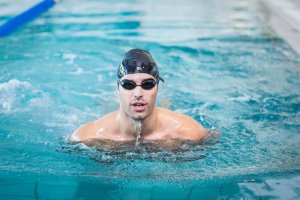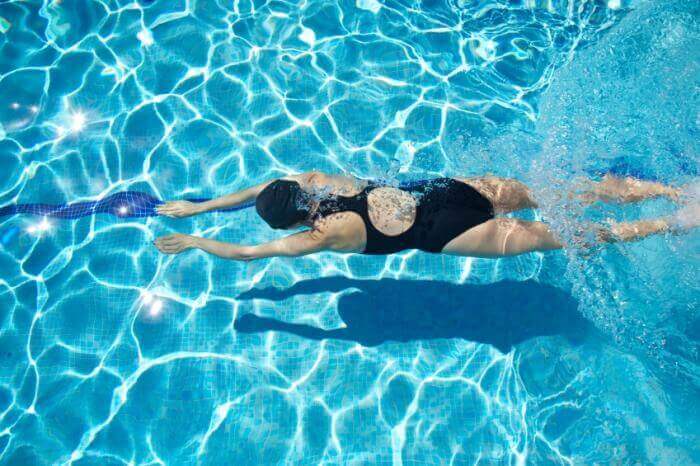How to Learn to Swim in a Pool

Learning to swim in a pool can make you feel much safer than if you try it first on a beach. The swell and the possible currents that form along shore and pull you out can cause a lot of fear, which won’t help you learn how to swim.
A pool is a safe place where you can take advantage of the shallow areas first. By having stairs and railings to hold on to, you’ll also know that there’s no way you’re going to drown.
How should you start learning how to swim in a pool?
We’ll give you some pointers for how to begin.
Choose a Spot Where You can Stand Up

To learn to swim in a pool, you’ll need to start in a part where the water doesn’t come up too high and you can stand. If the water is deeper than your chest, it can cause a lot of anxiety at first.
The important thing is that you feel calm and relaxed, otherwise it will be impossible to learn to swim. Let’s examine some specific steps you should take to get started:
- Feet first: Holding on to a ladder or the railing at the edge of the pool, let your body float and move your feet. This will give you enough confidence that you won’t sink. You can try different foot movements that correspond to different swim strokes.
- Try swimming: Once you control the movement of your feet, you should first practice a chest swim stroke, known more broadly as the frog. Your legs will bend and straighten at the same time as your arms out in front of your body.
Do not miss: Swimming: a Whole Body Workout
Before you start swimming on your own, make yourself feel more secure by holding on to a float or having someone hold you steady while you move your arms. This will help you build confidence.
Pay Attention to Your Breathing
Learning to swim in a pool doesn’t just require physical coordination. In addition, you also have to pay attention to your breathing. This will allow you to spend more or less time in the water, depending on how you do it.
It’s normal to breathe a little fast at first and you’ll feel exhausted quickly. You might be wondering at this stage how some people spend a lot of time in the water.
Every style of swimming has its own breathing technique. The kind where your head is submerged requires that you maintain a rhythm with your breaths. When your head is out of the water, you’ll take in a large amount of air. It’s normal not to breathe in enough at first.
Learning to swim will increase your lung capacity, so until you have enough practice, you’ll feel like you’re not getting enough air or you might drown. Nothing is going to happen to you, though. Keep trying.
Discover: 6 Tips to Prevent Arthrosis
Add Difficulty

As you begin to feel more safe in the water and can correctly perform the frog stroke without exhausting yourself too much, add a little difficulty. Here are some ideas.
- Try to go into deeper water: Even if you can still stand up, try to get closer to the deeper areas of the pool. This will test your confidence and you’ll eventually be able to swim in places where you can’t touch the bottom without fear of drowning.
- Try other strokes: Once you master the basic swim stroke, don’t just stick with that. There are many other strokes you can learn, like the butterfly or the crawl. Adding difficulty will improve your swimming skill and abilities.
Swimming has lots of health benefits and is one of the best exercises available to you. It’s also a very complete form of exercise that works all the parts of your body. That’s why taking the time to learn to swim can be very good for you.
Still don’t know how to swim? Have you tried but you gave up too early?
Don’t be discouraged. With time, you’ll learn to master it. Swimming is a complete workout that you can enjoy in a pool or at the beach. What better way than to enjoy yourself while exercising at the same time?
All cited sources were thoroughly reviewed by our team to ensure their quality, reliability, currency, and validity. The bibliography of this article was considered reliable and of academic or scientific accuracy.
-
Soler, J. M. (1952). Natación. Natación. Publicado Mensualmente Por El Club Natación de Barcelona. https://doi.org/10.1016/S0304-405X(99)00053-7
-
Maglione, J. (2008). Manual natación para todos – natación para la vida. FEDERACION INTERNACIONAL DE NATACION.
-
Santos Pereira, J., Silva, J. E. da, Martin Dantas, E. H., Natali, A. J., & Vale, R. G. de S. (2006). Efectos crónicos de un programa regular de natación. Sobre la tensión arterial de adultos hipertensos. RICYDE: Revista Internacional de Ciencias Del Deporte = International Journal of Sport Science. https://doi.org/10.5232/ricyde2006.00402
This text is provided for informational purposes only and does not replace consultation with a professional. If in doubt, consult your specialist.








